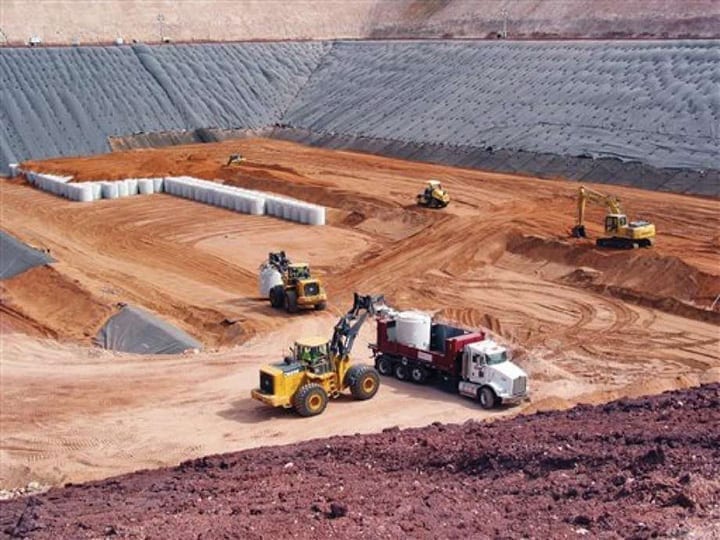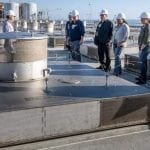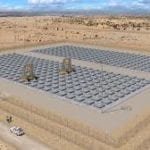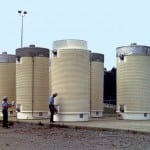Industry experts agree that deep geological repositories are needed for long-term storage of spent reactor fuel. They’re also digging for alternative methods.
The U.S. Department of Energy earlier this year said the nation’s nuclear reactors generate about 2,000 metric tons of used fuel annually. The agency said the U.S. nuclear power industry has produced about 83,000 metric tons of used fuel since the 1950s, with commercial used fuel rods stored at 76 reactor or storage sites in 34 states.
Worldwide, more than a quarter-million metric tons of radioactive nuclear waste sits in storage. That includes used fuel, and the waste from facilities involved in producing nuclear weapons or that reprocess and recycle used power plant fuel.
For more insight into the disposal of nuclear waste, read the POWER Interview with nuclear engineer and entrepreneur Leslie Dewan.
Permanent disposal of this waste has been a contentious issue. Several countries, including Switzerland, Finland, and others in Europe, have studied and planned deep geological repositories for their nuclear waste. Finland is furthest along; construction of the Onkalo disposal facility, the world’s first permanent geological repository, is ongoing, with the site scheduled to begin operating in 2025.
The U.S. has sought a permanent solution for nuclear waste for decades. The focus for more than 30 years has been on Yucca Mountain in Nevada, a site about 100 miles northwest of Las Vegas. But Yucca Mountain’s status has been in limbo almost since it received its designation in 1987 as part of amendments to the Nuclear Waste Policy Act, adopted by Congress in 1982. The site has been in and out of favor owing to the political winds, both in Nevada and nationally.
“The optimal solution to the spent nuclear fuel challenge is to reprocess it into new fuel, as has been done in France for decades, and is also currently practiced in some measure by the UK, India, Japan, Russia, and China,” said Tim Farward, U.S. Nuclear Energy Practice Leader for Marsh, an insurance broker and risk management solutions company for industries including energy providers. Farward told POWER, “For perspective, the French have recycled enough spent fuel to power their 56-reactor nuclear fleet for 14 years. This is not a perfect solution, as some high-level waste is produced, which must typically be vitrified, and it does involve a great deal of transportation of spent fuel. Although some reprocessing will likely be in the future of nuclear power in the United States, it is not likely a near-term solution as it requires a substantial investment, resolving issues with previous historical reprocessing efforts, and would ultimately increase the cost of nuclear fuel.”
U.S. nuclear waste, like waste across much of the world, remains in interim storage, though analysts admit the interim tag could in fact become the permanent solution.
Political Obstacles
“I don’t believe there is a silver bullet, and there is not a single approach that provides the best solution,” Julianne Antrobus, head of nuclear with global consultancy PA Consulting, told POWER. Antrobus formerly was responsible for developing the strategic direction of Atkins’ nuclear division, part of the SNC-Lavalin Group.
“The decision of how to deal with nuclear waste from existing facilities is a national policy decision but influenced by local considerations and dominated by the host communities that will provide the most optimum location for such a facility,” Antrobus said. “These locations are often in remote and sometimes economically challenged areas.”
Nevada officials have repeatedly argued against Yucca Mountain, even after $15 billion was spent to develop the site after its selection by Congress during the Reagan administration. President Trump when he took office promised to revive the Yucca Mountain project, and earmarked money for the repository in the federal budget process. In February of this year, though, he reversed course and said he opposed the project. Now private companies are looking to build storage sites that could serve as large-scale repositories.
 |
|
1. Waste Control Specialists already is accepting low-level nuclear waste at this location in West Texas. The company is part of a group seeking Nuclear Regulatory Commission approval for a consolidated interim storage facility for used fuel from the nation’s reactors. Courtesy: Waste Control Specialists |
Interim Storage Partners, formed by Orano USA and Waste Control Specialists (WCS), wants to store as much as 40,000 metric tons of used nuclear fuel at an existing facility in Andrews County in West Texas (Figure 1), where WCS is already accepting low-level nuclear waste. The group is seeking a 40-year license from the Nuclear Regulatory Commission (NRC) for what is known as a consolidated interim storage facility (CISF).
Holtec International has proposed a CISF facility in New Mexico. That site, 35 miles from Carlsbad in the desert in the southeastern part of the state, could eventually hold up to 100,000 metric tons of nuclear waste.
“There are two things to consider,” said Antrobus. “First, the host communities need to be accepting of such a facility. Second, the facility needs to bolster the community. With the right planning and approach, host communities that accept such a facility could see investment in local infrastructure, hospital development, enhanced programs for schools, job creation from construction and operations of the facility, etc.”
Interim Options
Joe Delmar, senior director, Government Affairs & Communications for Holtec International, told POWER that the company’s proposed HI-STORE CISF in New Mexico “continues through the NRC licensing process. The NRC issued the draft environmental impact statement [EIS] and found no environmental reason that would prevent a license from being issued. Due to COVID, the NRC has conducted two public meetings on the draft EIS and has extended the public comment period until September 22. The NRC is also conducting a safety review of the HI-STORE project.” He said, “The NRC has indicated a license could be issued in 2021 based on the current schedule.”
Holtec has touted the safety of its storage system; the risk of accidents that would cause radiation to leak into the surrounding area has been an argument against interim storage sites and against the transport of nuclear waste to those sites.
Delmar said Holtec’s “HI-STORE CISF utilizes Holtec’s HI-STORM UMAX vertical ventilation dry storage system, which is engineered to be immune to extreme environmental phenomena, such as hurricanes, floods, tornados, and earthquakes. The canisters are stored in underground, concrete and steel cavities making them essentially impenetrable. HI-STORE CISF is designed to withstand a crashing aircraft or an unlikely on-site fire without any radiological impact.”
John Buchser, nuclear waste issues chair for the Rio Grande chapter of the Sierra Club, said that while the environmental group is opposed to the New Mexico site, the Holtec system “is a good example of hardening” when it comes to storage. He said his group is most concerned with the transportation of nuclear waste from current onsite storage facilities.
“Probably one of the largest issues is the risk of transportation [of nuclear waste],” Buchser told POWER. “There are probably at least 10 [nuclear power plants] with concerns about storage onsite.” Buchser said companies such as Holtec have “tried to do a good job with the design of those [storage] casks, and they’re probably good for 50 to 100 years, but we need to have procedures in place to address any leakage. One concern is a ‘return to sender’ if it’s leaking. If it’s leaking, you’re going to send it back? I don’t think so.”
Going Underground
There are many techniques for disposing of nuclear waste, including geological disposal such as that proposed at Yucca Mountain. That method includes several types of underground storage.
Deep Isolation, a Berkeley, California-based company that engineers nuclear waste disposal solutions, in late July signed a long-term cooperation and licensing agreement with NAC International Inc. (NAC) to design, manufacture, and supply canisters that will be used to safely store and/or dispose of nuclear waste in deep horizontal boreholes. NAC, a leading nuclear fuel cycle consulting and technology solutions company, specializes in systems for the storage, transportation, and disposal of spent nuclear fuel, high-level waste, and other nuclear materials.
Rod Baltzer, Deep Isolation’s chief operating officer, told POWER his company “takes the approach of deploying a solution that could be deployed modularly at existing reactor sites where the waste is [or was] generated, or at a location [or locations] that is more regional or centrally located. This will depend upon what our customers and stakeholders prefer and will be based upon mutual consent.”
The World Nuclear Association (WNA) earlier this year, in an update to its recommendations for nuclear waste disposal, said that high-level waste should be stored for about 50 years before permanent disposal to allow the radioactivity to decay. The WNA also said, “Disposal of low-level waste is straightforward and can be undertaken safely almost anywhere,” and said, “Storage of used fuel is normally under water for at least five years and then often in dry storage.” The group noted that “Deep geological disposal is widely agreed to be the best solution for final disposal of the most radioactive waste produced.”
Baltzer said Deep Isolation is “seeking geologic environments that are optimally suited to dispose of nuclear waste and keep it isolated from humans for as long as it poses a health risk. The drillholes can be located in sedimentary, igneous or metamorphic host rocks far below aquifers, where water has had no contact with the surface for a million years or more. We believe our solution provides an additional disposition pathway for commercial spent nuclear fuel and DOE high-level waste inventories and should be considered by stakeholders and policymakers seeking a permanent disposal option. We agree with the international scientific consensus that deep geologic isolation is the preferred safe, permanent disposal solution for high-level nuclear waste and spent nuclear fuel.”
Switzerland is among the countries working on geological disposal. The National Cooperative for the Disposal of Radioactive Waste (Nagra), in charge of the country’s effort, in mid-July said it has completed drilling of the Marthalen borehole, saying, “Taking the results together with the information from the Trüllikon borehole, the earlier borehole in Benken and other investigations, the picture of the underground in the Zürich Nordost siting region is becoming more complete.” The group said it had drilled to a depth of 1,100 meters, studying the boreholes in the Opalinus Clay host rock where its repository is planned.
Philipp Senn, Nagra’s deputy division head for Collaboration Sectoral Plan and Public Outreach, said, “The results to date from the boreholes in Trüllikon and Marthalen, the earlier borehole in Benken and other investigations give a consistent picture of the underground environment in [the] Zürich Nordost siting region.” The group said three regions have been identified “as suitable in principle for the construction of a repository. Nagra’s objective in drilling the deep boreholes is to find out which of the three regions is best suited.” The group said it expects to announce in 2022 which region it will submit for a license.
 |
|
2. A final disposal canister for spent nuclear fuel is among the items on display at the Olkiluoto Nuclear Power Plant visitor center in Finland. Courtesy: Creative Commons / Teemu Väisänen |
The Onkalo nuclear waste disposal facility under construction in Finland is a $555 million project that will be operated by Posiva, a joint venture between Teollisuuden Voima (TVO, with a 60% stake), and Fortum Power and Heat (40%). Posiva will be responsible for the final disposal of nuclear waste produced by TVO’s Olkiluoto nuclear power plant (Figure 2), as well as Fortum’s Loviisa nuclear plant in Finland. The site, located on Olkiluoto Island near Finland’s west coast, is expected to hold as much as 6,500 metric tons of spent nuclear fuel over an estimated operational life of 100 years.
“Deep geologic repositories remain the answer embraced by most who have studied it,” said Farward, who added that “Maintaining spent nuclear fuel at a large number of discrete sites with limited security perimeters does not make good risk management sense for the long term.
“[The] logical intermediate step, which can be taken as our government works to develop a final solution to this issue, requires amendment to the Nuclear Policy Waste Act in order to allow for interim storage facilities to operate without an ultimate destination in a geologic repository,” he said. ■
—Darrell Proctor is associate editor for POWER (@DarrellProctor1, @POWERmagazine).










